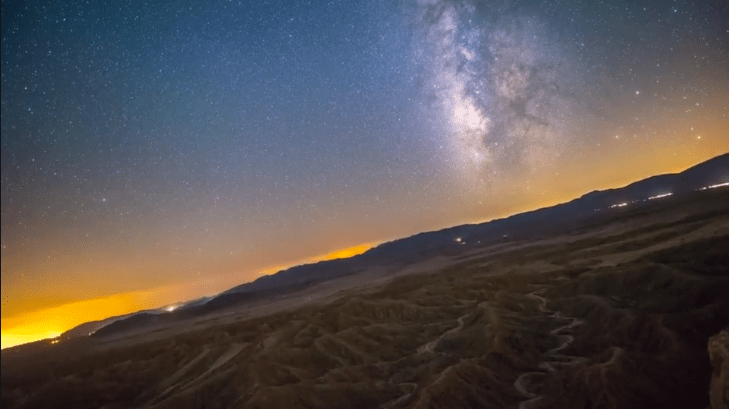Photographer Eric Brummel has created a stunning time-lapse of the Milky Way. Time-lapses of the Milky Way are not rare, but Eric has turned convention on its head. Instead of the Milky Way moving across the night sky, it’s the Earth that’s in motion.
Continue reading “This Astrophotographer Makes the World Turn and the Sky Stand Still”You’re Looking at an Actual Image of a White Dwarf Feeding on Material from a Larger Red Giant, 650 Light Years from Earth.
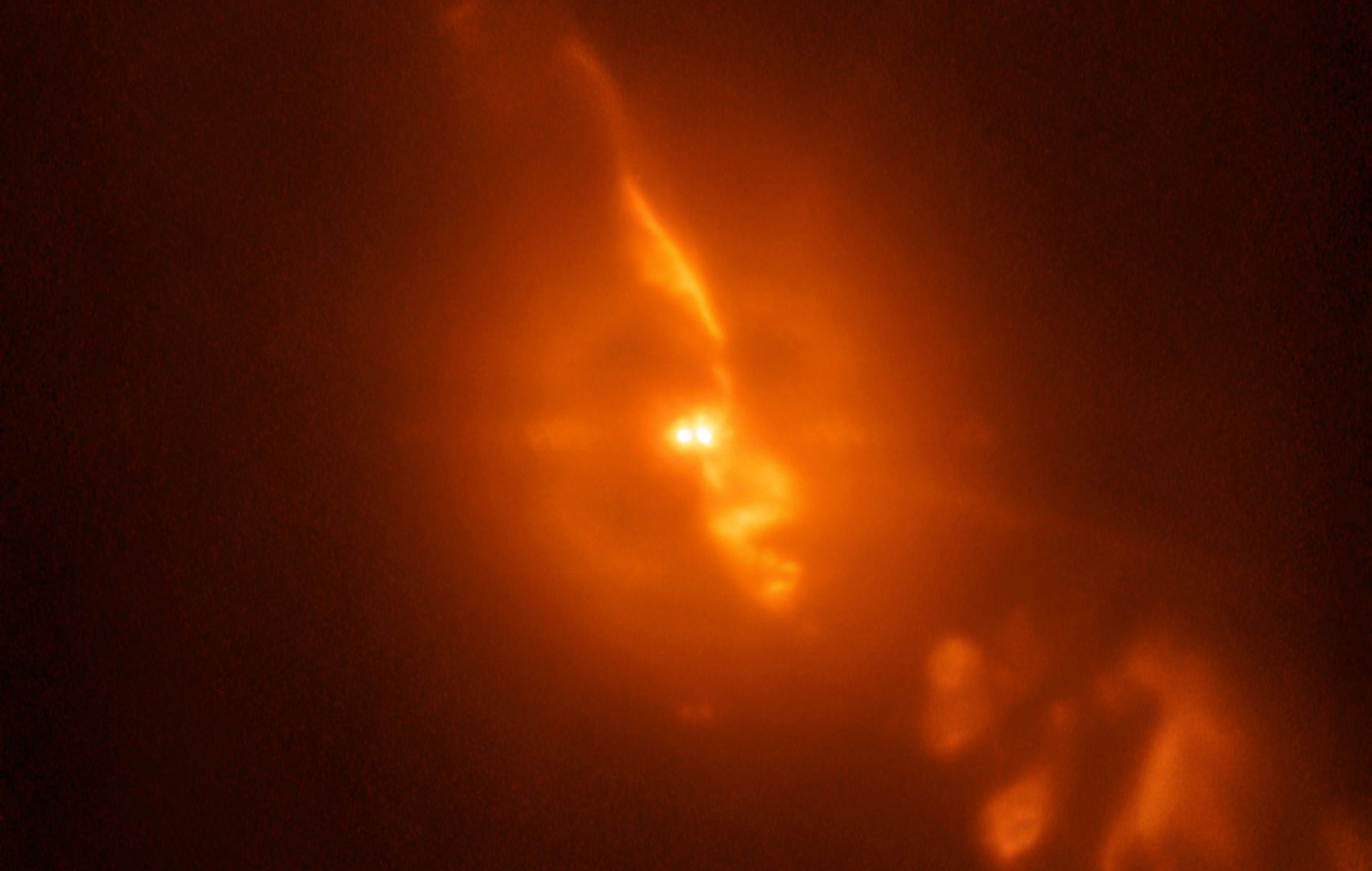
The SPHERE planet-hunting instrument on the European Southern Observatory’s Very Large Telescope captured this image of a white dwarf feeding on its companion star, a type of Red Giant called a Mira variable. Most stars exist in binary systems, and they spend an eternity serenely orbiting their common center of gravity. But something almost sinister is going on between these two.
Astronomers at the ESO have been observing the pair for years and have uncovered what they call a “peculiar story.” The Red Giant is a Mira variable, meaning it’s near the end of its life, and it’s pulsing up to 1,000 times as bright as our Sun. Each time it pulses, its gaseous envelope expands, and the smaller White Dwarf strips material from the Red Giant.
Astrophotographer Captures Musk’s Tesla Roadster Moving Through Space
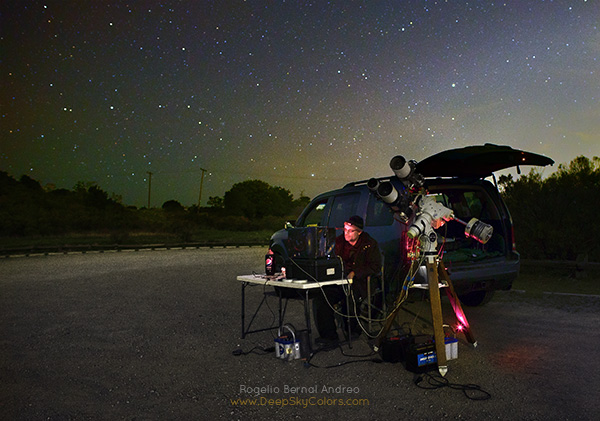
An astrophotographer in California has captured images of Elon Musk’s Tesla Roadster on its journey around our Sun. In the early morning of February 9th, Rogelio Bernal Andreo captured images of the Roadster as it appeared just above the horizon. To get the images, Andreo made use of an impressive arsenal of technological tools.
Andreo knew that photographing the Roadster would be a challenge, since it was over a million miles away at the time. But he has the experience and equipment to pull it off. The first task was to determine where the Tesla would be in the sky. Luckily, NASA’s JPL creates lists of coordinates for objects in the sky, called ephemerides. Andreo found the ephemeris for Starman and the Roadster, and it showed that the pair would be in the Hydra constellation, and that they would be only about 20 degrees above the horizon. That’s a challenge, because it means photographing through more atmospheric density.

However, the Roadster and its driver would be bright enough to do it. As Andreo says in his blog, “The ephemeris from the JPL also indicated that the Roadster’s brightness would be at magnitude 17.5, and I knew that’s perfectly achievable.” So he gathered his gear, hopped in his vehicle, and went for it.
Andreo’s destination was the Monte Bello Open Space Preserve, a controlled-access area for which he has a night-time use permit. This area is kind of close to the San Francisco Bay Area, so the sky is a little bright for astrophotography, but since the Roadster has a magnitude of 17.5, he thought it was doable. Plus, it’s a short drive from his home.
Once he arrived there, he set up his impressive array of gear: dual telescopes and cameras, along with a tracking telescope and computers running specialized software. Andreo explains it best:
“Let me give you a brief description of my gear – also the one I use for most of my deep-sky images. I have a dual telescope system: two identical telescopes and cameras in parallel, shooting simultaneously at the very same area of the sky – same FOV, save a few pixels. The telescopes are Takahashi FSQ106EDX. Their aperture is 106mm (about 4″) and they give you a native 530mm focal length at f/5. The cameras are SBIG STL11k monochrome CCD cameras, one of the most legendary full-frame CCD cameras for astronomy (not the best one today, mind you, but still pretty decent). All this gear sits on a Takahashi EM-400 mount, the beast that will move it at hair-thin precision during the long exposures. I brought the temperature of the CCD sensors to -20C degrees (-4F) using the CCD’s internal cooling system.”
CCD’s with internal cooling systems. Very impressive!

Andreo uses a specialized focusing system to get his images. He uses focusers from Robofocus and precision focusing software called FocusMax. He also uses a third, smaller telescope called an autoguider. It focuses on a single star in the Field of View and follows it religiously. When that star moves, the whole rig moves. As Andreo says on his blog, “Autoguiding provides a much better mount movement than tracking, which is leaving up to the mount to blindly “follow” the sky. By actually “following” a star, we can make sure there’ll be no trails whether our exposures are 2 or 30 minutes long.”
Once he was all set up, there was time pressure. The Roadster would only be above the horizon for a short time and the Moon was coming up and threatening to wash out the sky. Andreo got going, but his first shots showed nothing.

Andreo felt that once he got home and could process the images properly, the Tesla Roadster and its driver would be somewhere in his images. He kept taking pictures until about 5 AM. Cold and tired, he finally packed up his gear and went home.
“…no matter what I did, I could not find the Roadster.” Astrophotographer Rogelio Bernal Andreo
After some sleep, he began working with his images. “After a few hours of sleep, I started playing with the data and no matter what I did, I could not find the Roadster. I kept checking the coordinates, nothing made sense. So I decided to try again. The only difference would be that this time the Moon would rise around 3:30am, so I could try star imaging at 2:30am and get one hour of Moon-free skies, maybe that would help.”

So Andreo set out to capture the Roadster again. The next night, at the same location, he set up his gear again. But this time, some clouds rolled in, and Andreo got discouraged. He stayed to wait for the sky to improve, but it didn’t. By about 4 AM he packed up and headed home.
After a nap, he went over his photos, but still couldn’t find the Roadster. It was a puzzle, because he knew the Roadster’s coordinates. Andreo is no rookie, his photos have been published many times in Astronomy Magazine, Sky and Telescope, National Geographic, and other places. His work has also been chosen as NASA’s APOD (Astronomy Picture of the Day) more than 50 times. So when he can’t find something in his images that should be there, it’s puzzling.
Then he had an A-HA! moment:
“Then it hit me!! When I created the ephemeris from the JPL’s website, I did not enter my coordinates!! I went with the default, whatever that might be! Since the Roadster is still fairly close to us, parallax is significant, meaning, different locations on Earth will see Starman at slightly different coordinates. I quickly recalculate, get the new coordinates, go to my images and thanks to the wide field captured by my telescopes… boom!! There it was!! Impossible to miss!! It had been right there all along, I just never noticed!”
Andreo is clearly a dedicated astrophotographer, and this is a neat victory for him. He deserves a tip of the hat from space fans. Why not check out his website—his gallery is amazing!—and share a comment with him.
Rogelio Bernal Andreo’s website: DeepSkyColors.com
His gallery: http://www.deepskycolors.com/rba_collections.html
Also, check out his Flickr page: https://www.flickr.com/photos/deepskycolors/
Andreo explained how he got the Roadster images in this post on his blog: Capturing Starman from 1 Million Miles
Incredible Solar Eclipse Images From Our Readers
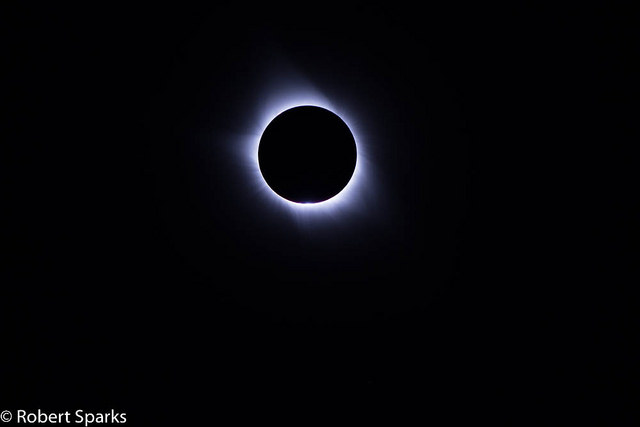
Holy moly, that was awesome! Incredible, fantastic, amazing…there just aren’t the words to describe what it is like to experience totality. While I’m trying to come down to Earth and figure out how to explain how wonderful this was, enjoy the beautiful images captured by our readers from across the US and those from across the world who traveled to capture one of nature’s most spectacular events: a total solar eclipse.
The images from those seeing partial eclipses are wonderful, as well, and we’ll keep adding them as they come in (update, we just got some from Europe too). Great job everyone!

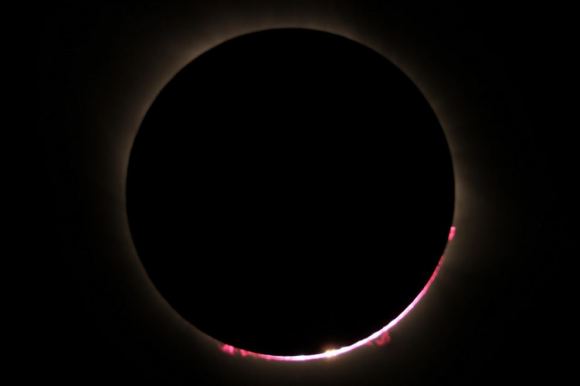
Celestron C8 Telescope on CGEM. Canon T3i (Modified IR enhanced), Solar Filter. Credit and copyright: Michael Bee.
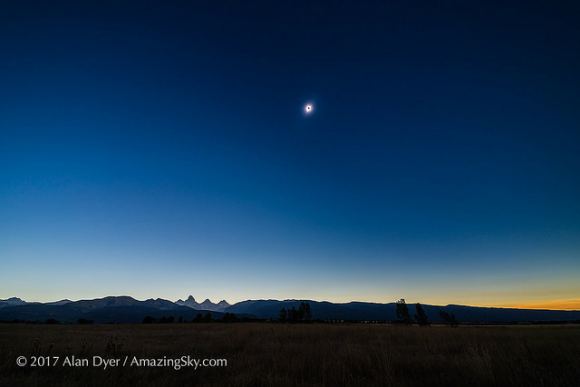
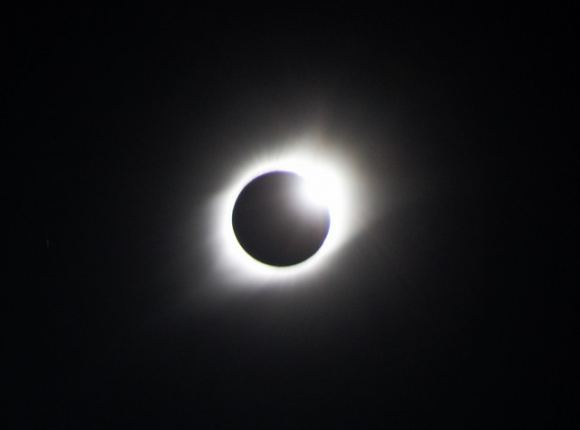
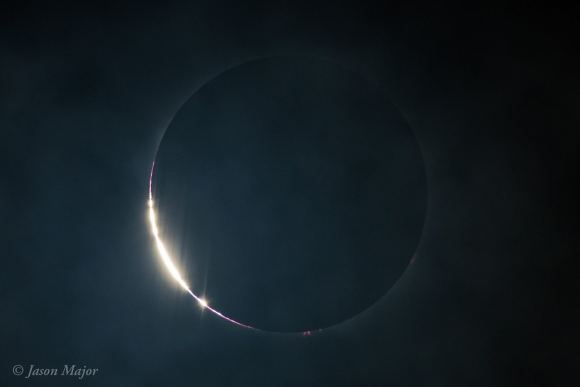

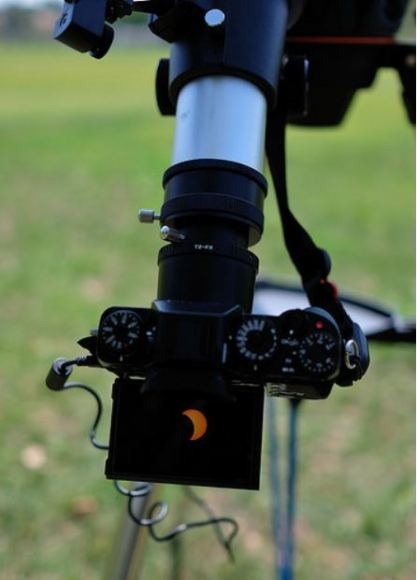
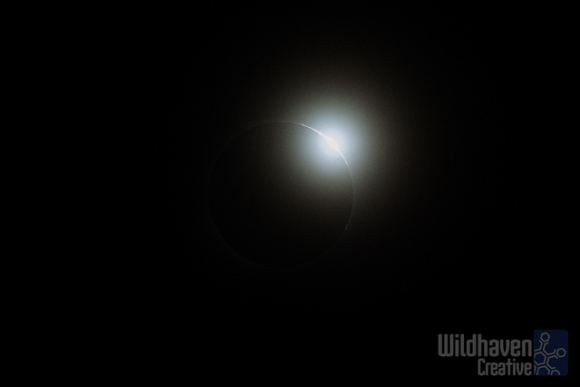
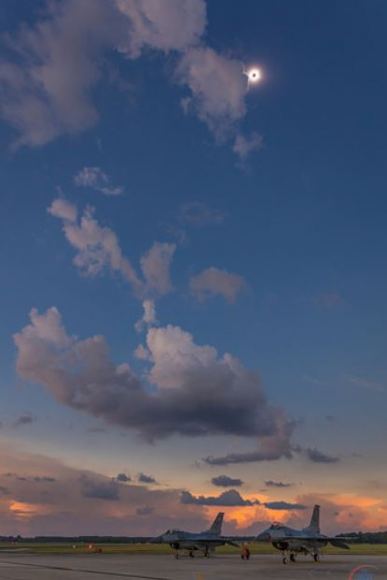
#Eclipse 2017 From Laval. Aug 21 2017. @CosmodomeLaval #meteoqc @universetoday pic.twitter.com/HFAeH695dD
— FelipeSg (@SanFelipeSG) August 21, 2017
#Timelapse of totality over Salem, #Oregon. So cool! #eclipse2017 @universetoday @JimCantore @ericfisher @StephanieAbrams @ZachsORoutdoors pic.twitter.com/TzV4Vil2xq
— Mike Cohea (@MikeCohea) August 21, 2017
Short video I took from McMinnville, TN. Can you see it!!! ?? #Eclipse2017 pic.twitter.com/zVNXvLOLSI
— Holly ? (@absolutspacegrl) August 21, 2017
That moment of #SolarEclipse2017 pic.twitter.com/8u8Xz79aWi
— Zaid Benjamin (@zaidbenjamin) August 21, 2017
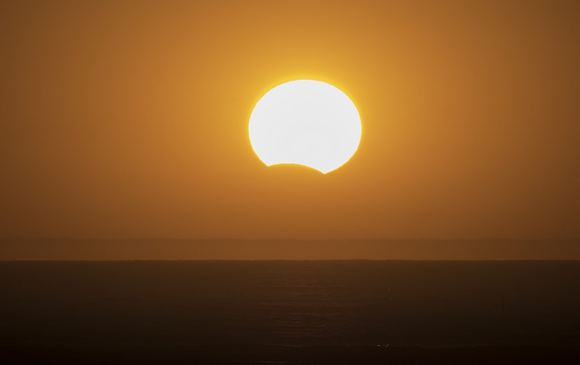
Aerial panorama of the total solar eclipse over Kansas. Two minutes earlier it was still raining. #eclipse #eclipse2017 @DJIGlobal pic.twitter.com/1zSIsKlZ8E
— Romeo Durscher (@romeoch) August 21, 2017
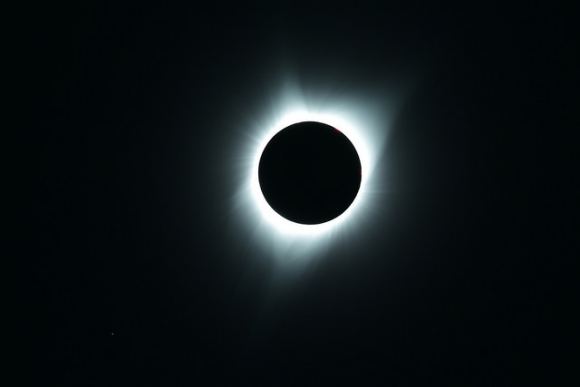
Still sorting through the 850+ photos I shot today, a rough edit #Eclipse2017 pic.twitter.com/r4SC4YABtD
— Tony Rice (@rtphokie) August 21, 2017
Can Astronauts See Stars From the Space Station?
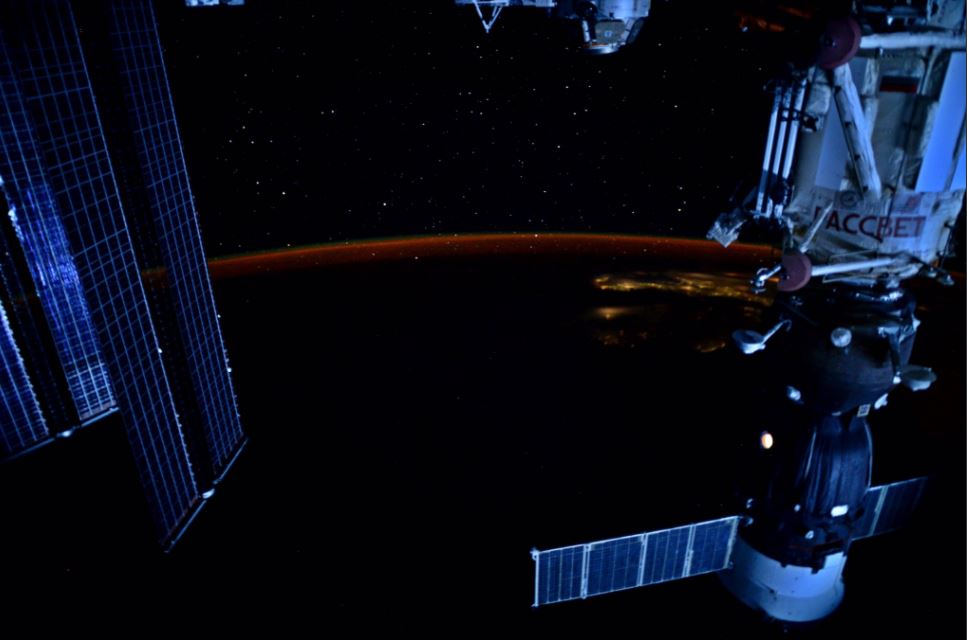
I’ve often been asked the question, “Can the astronauts on the Space Station see the stars?” Astronaut Jack Fischer provides an unequivocal answer of “yes!” with a recent post on Twitter of a timelapse he took from the ISS. Fischer captured the arc of the Milky Way in all its glory, saying it “paints the heavens in a thick coat of awesome-sauce!”
Can you see stars from up here? Oh yeah baby! Check out the Milky Way as it spins & paints the heavens in a thick coat of awesome-sauce! pic.twitter.com/MsXeNHPxLF
— Jack Fischer (@Astro2fish) August 16, 2017
But, you might be saying, “how can this be? I thought the astronauts on the Moon couldn’t see any stars, so how can anyone see stars in space?”
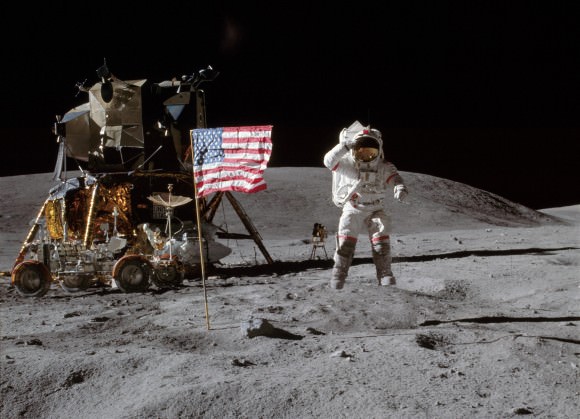
It is a common misconception that the Apollo astronauts didn’t see any stars. While stars don’t show up in the pictures from the Apollo missions, that’s because the camera exposures were set to allow for good images of the bright sunlit lunar surface, which included astronauts in bright white space suits and shiny spacecraft. Apollo astronauts reported they could see the brighter stars if they stood in the shadow of the Lunar Module, and also they saw stars while orbiting the far side of the Moon. Al Worden from Apollo 15 has said the sky was “awash with stars” in the view from the far side of the Moon that was not in daylight.
Just like stargazers on Earth need dark skies to see stars, so too when you’re in space.
The cool thing about being in the ISS is that astronauts experience nighttime 16 times a day (in 45 minute intervals) as they orbit the Earth every 90 minutes, and can have extremely dark skies when they are on the “dark” side of Earth. Here’s another recent picture from Fischer where stars can be seen:
Twinkle, twinkle, little star…
Up above the world so high
Like a diamond in the sky… pic.twitter.com/8H7CshyP0p— Jack Fischer (@Astro2fish) August 13, 2017
For stars to show up in any image, its all about the exposure settings. For example, if you are outside (on Earth) on a dark night and can see thousands of stars, if you just take your camera or phone camera and snap a quick picture, you’ll just get a darkness. Earth-bound astrophotographers need long-exposure shots to capture the Milky Way. Same is true with ISS astronauts: if they take long-exposure shots, they can get stunning images like this one:
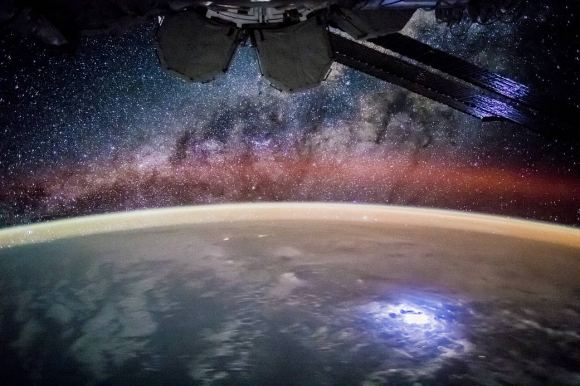
This image, set to capture the bright solar arrays and the rather bright Earth (even though its in twilight) reveals no stars:
Sometimes you look out the window and it just takes your breath away from how beautiful Earth is. Today is one of those times… #EarthShapes pic.twitter.com/53UqL9BFH1
— Jack Fischer (@Astro2fish) August 2, 2017
In this timelapse of Earth at night, a few stars show up, but again, the main goal here was to have the camera capture the Earth:
Universe Today’s Bob King has a good, detailed explanation of how astronauts on the ISS can see stars on his Astro Bob blog Astrophysicist . Brian Koberlein explains it on his blog, here.
You can check out all the images that NASA astronauts take from the ISS on the “Astronaut Photography of Earth” site, and almost all the ISS astronauts and cosmonauts have social media accounts where they post pictures. Jack Fischer, currently on board, tweets great images and videos frequently here.
Gorgeous Images of the August 2017 Partial Lunar Eclipse

Just to get you in the mood for the upcoming total solar eclipse — now less than two weeks away — our Solar System put on a little eclipse display of the lunar kind on August 7. The full Moon passed through part of the Earth’s umbral shadow, and the timing made this partial lunar eclipse visible in parts of Europe and Africa.
Thanks to our friends around the world who posted in Universe Today’s Flickr page, we’ve got images to share! Enjoy the views! Click on all the images to see larger versions of them on Flickr. The lead image link is here.
And for those of you in the path of the August 21 solar eclipse, please feel free to share your images on our Flickr page, and we may feature them in an upcoming article.
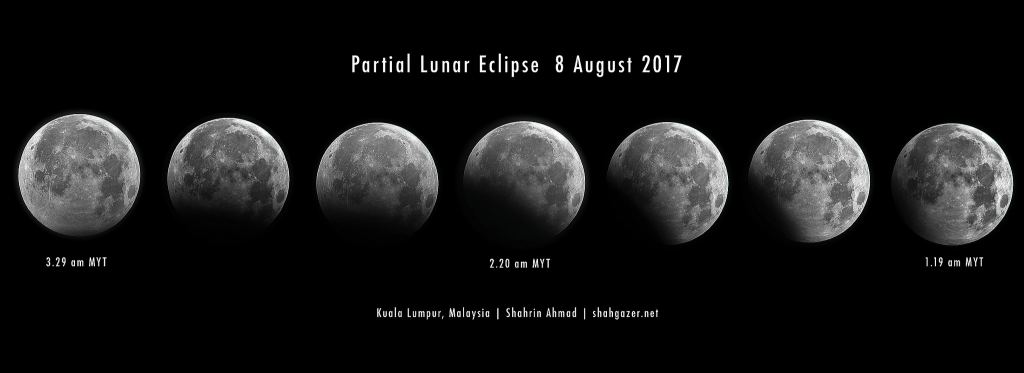
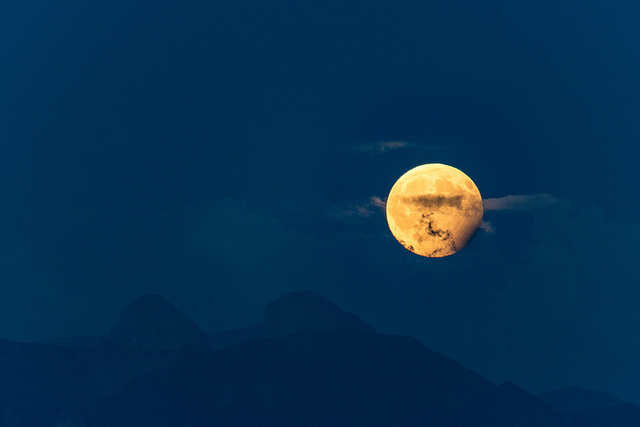
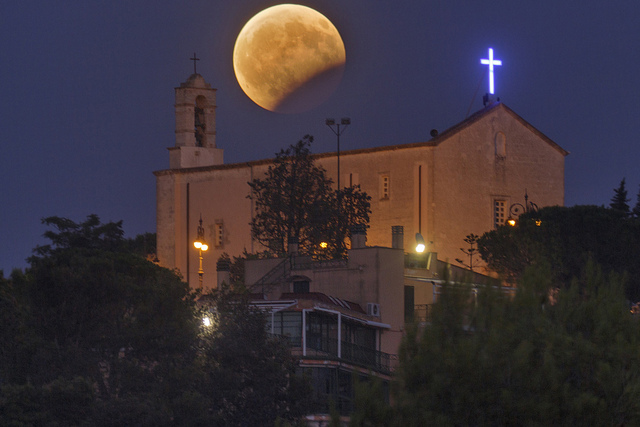
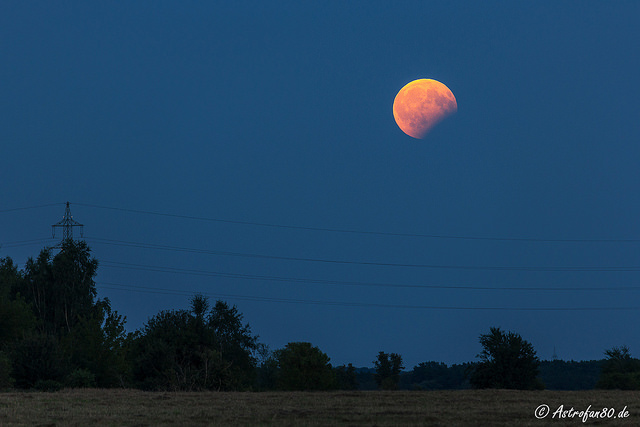
Eclipsed full moon over the eastern horizon as seen from Treppendorf, Brandenburg, Germany. Credit and copyright: Andreas Schnabel.
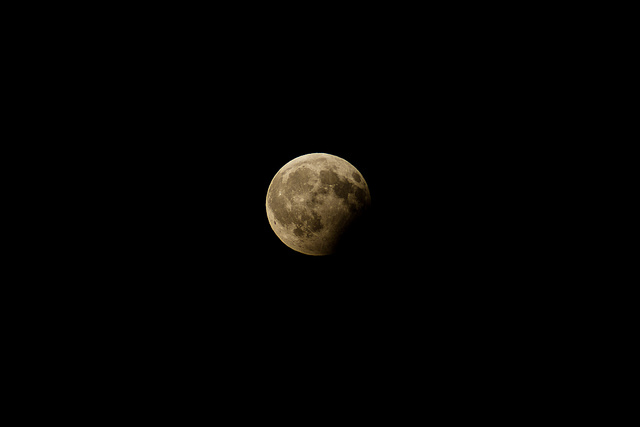
Stephan Haverland.
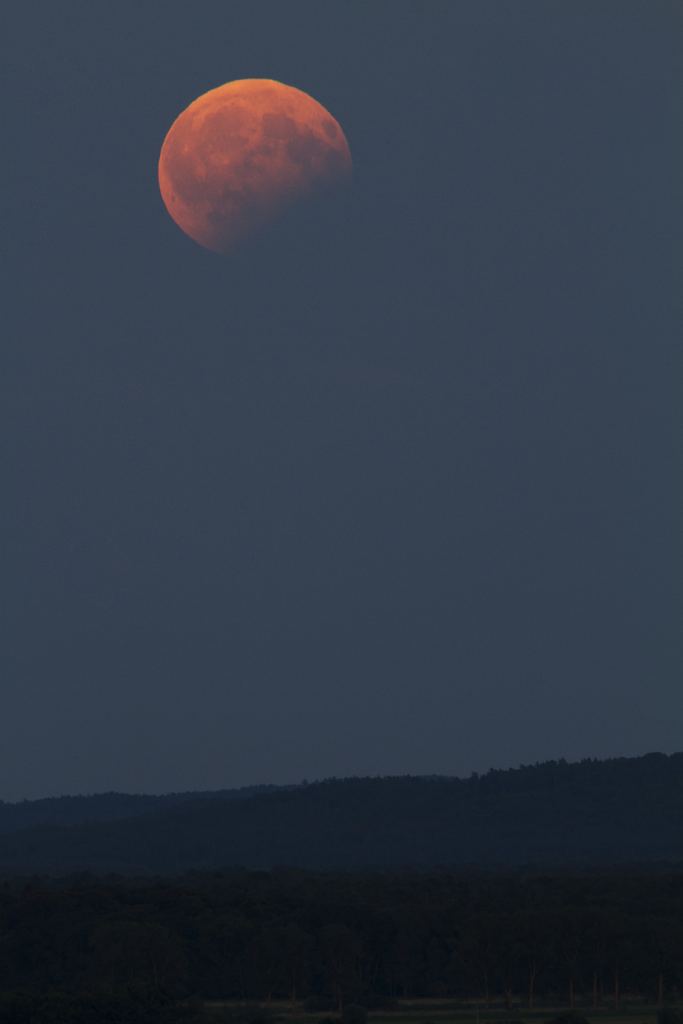
Pawel Warchal.
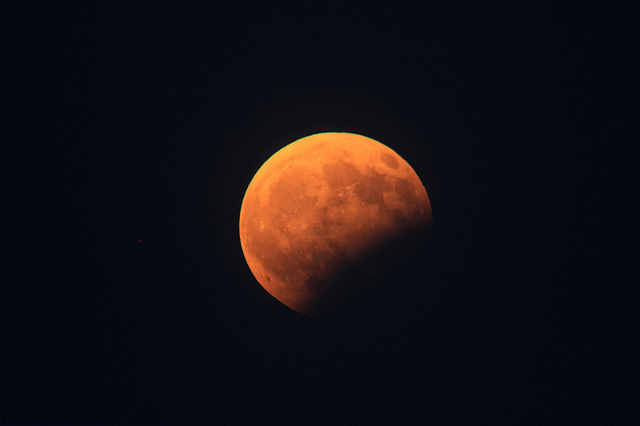
Here is a video of additional images from Leonard Mercer:
You can watch a reply of a live webcast from the Virtual Telescope Project of the partial lunar eclipse seen from Rome:
Amazing New Views of Betelgeuse Courtesy of ALMA
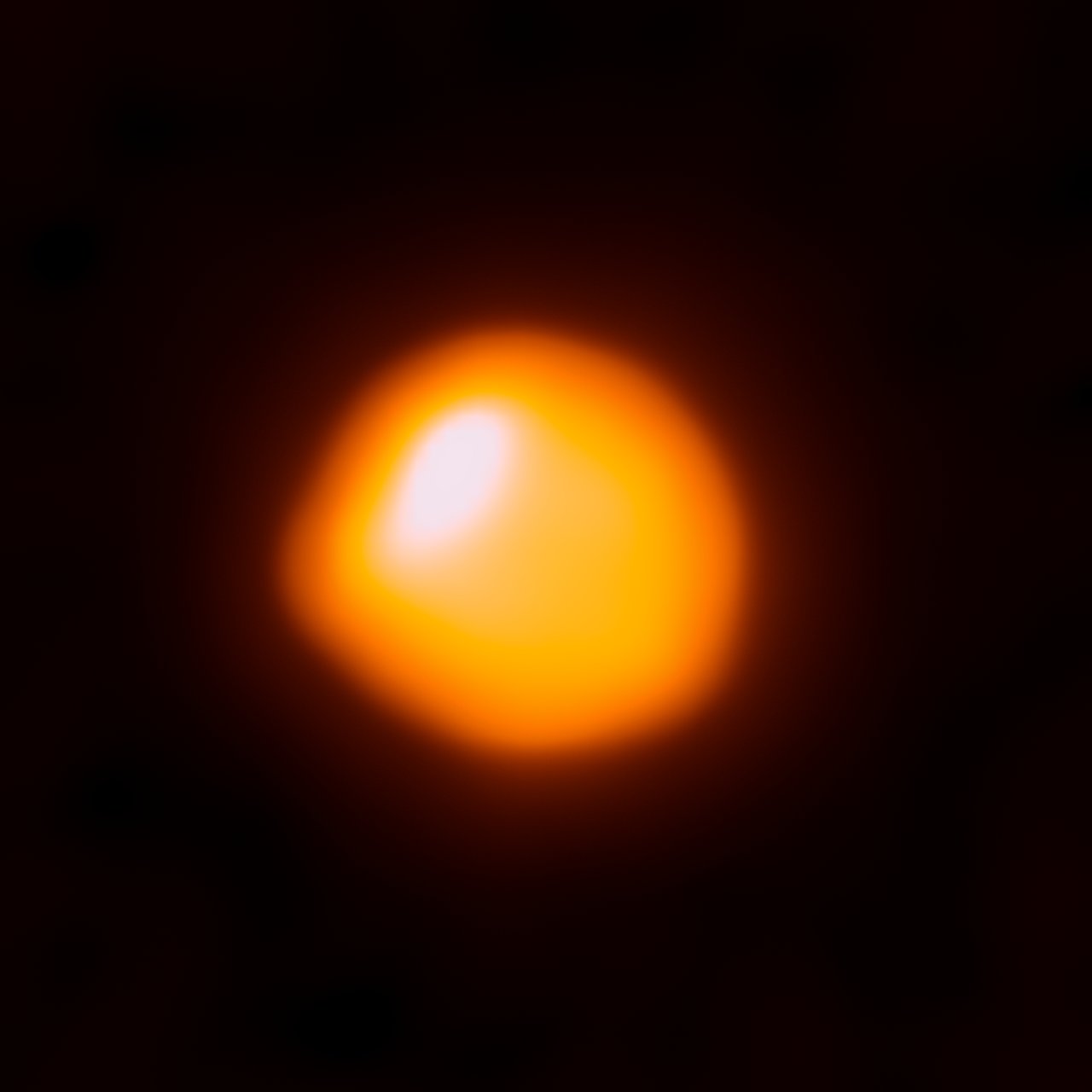
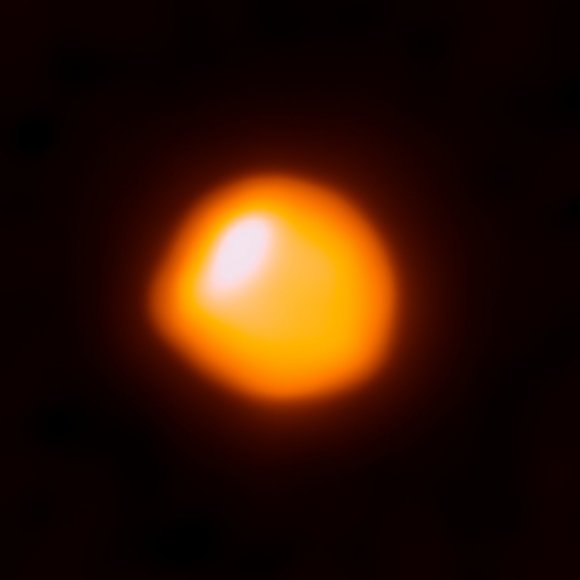
Just. Wow.
An angry monster lurks in the shoulder of the Hunter. We’re talking about the red giant star Betelgeuse, also known as Alpha Orionis in the constellation Orion. Recently, the Atacama Large Millimeter Array (ALMA) gave us an amazing view of Betelgeuse, one of the very few stars that is large enough to be resolved as anything more than a point of light.
Located 650 light years distant, Betelgeuse is destined to live fast, and die young. The star is only eight million years old – young as stars go. Consider, for instance, our own Sun, which has been shining as a Main Sequence star for more than 500 times longer at 4.6 billion years – and already, the star is destined to go supernova at anytime in the next few thousand years or so, again, in a cosmic blink of an eye.
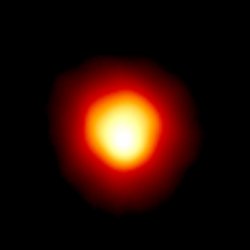
An estimated 12 times as massive as Sol, Betelgeuse is perhaps a staggering 6 AU or half a billion miles in diameter; plop it down in the center of our solar system, and the star might extend out past the orbit of Jupiter.
As with many astronomical images, the wow factor comes from knowing just what you’re seeing. The orange blob in the image is the hot roiling chromosphere of Betelgeuse, as viewed via ALMA at sub-millimeter wavelengths. Though massive, the star only appears 50 milliarcseconds across as seen from the Earth. To give you some idea just how small a milliarcsecond is, there’s a thousand of them in an arc second, and 60 arc seconds in an arc minute. The average Full Moon is 30 arc minutes across, or 1.8 million milliarcseconds in apparent diameter. Betelgeuse has one of the largest apparent diameters of any star in our night sky, exceeded only by R Doradus at 57 milliarcseconds.
The apparent diameter of Betelgeuse was first measured by Albert Michelson using the Mount Wilson 100-inch in 1920, who obtained an initial value of 240 million miles in diameter, about half the present accepted value, not a bad first attempt.
You can see hints of an asymmetrical bubble roiling across the surface of Betelgeuse in the ALMA image. Betelgeuse rotates once every 8.4 years. What’s going on under that uneasy surface? Infrared surveys show that the star is enveloped in an enormous bow-shock, a powder-keg of a star that will one day provide the Earth with an amazing light show.

Thankfully, Betelgeuse is well out of the supernova “kill zone” of 25 to 100 light years (depending on the study). Along with Spica at 250 light years distant in the constellation Virgo, both are prime nearby supernovae candidates that will on day give astronomers a chance to study the anatomy of a supernova explosion up close. Riding high to the south in the northern hemisphere nighttime sky in the wintertime, +0.5 magnitude Betelgeuse would most likely flare up to negative magnitudes and would easily be visible in the daytime if it popped off in the Spring or Fall. This time of year in June would be the worst, as Alpha Orionis only lies 15 degrees from the Sun!
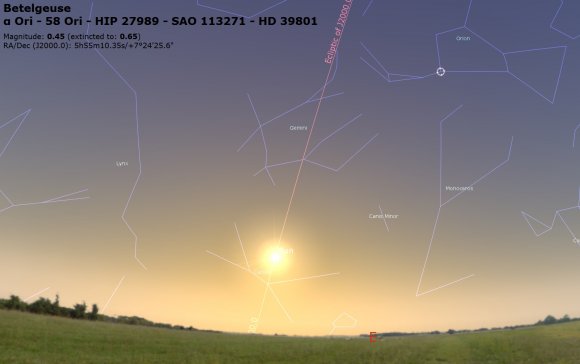
Of course, this cosmic spectacle could kick off tomorrow… or thousands of years from now. Maybe, the light of Betelgeuse gone supernova is already on its way now, traversing the 650 light years of open space. Ironically, the last naked eye supernova in our galaxy – Kepler’s Star in the constellation Ophiuchus in 1604 – kicked off just before Galileo first turned his crude telescope towards the heavens in 1610.
You could say we’re due.
Amazing Video: Watch SpaceX’s Dragon in Flight, as Seen From the Ground
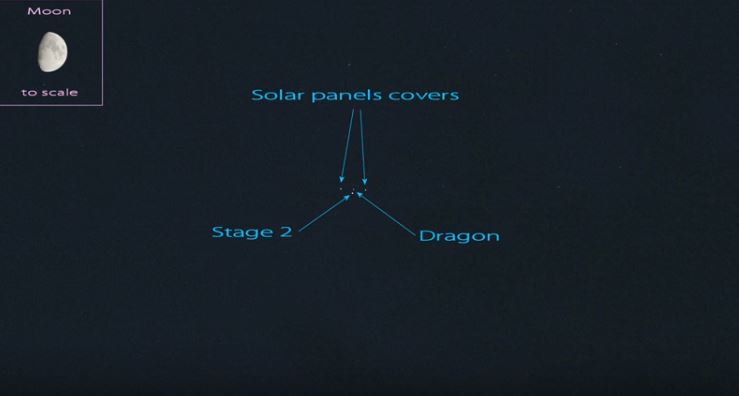
Always on the lookout for interesting events in the skies, astrophotographer Thierry Legault has captured an incredible video of SpaceX’s Dragon capsule traveling through space just 20 minutes after it launched from Kennedy Space Center on June 3, 2017.
“You can see the Dragon, the second stage of the Falcon 9 rocket, and solar panel covers,” Legault told Universe Today via email, “plus a nice surprise I discovered during processing: several fast ejections of material, certainly thrusters firing!”
Legault captured at least 6 ejections of material during the passage over his location in Tours, France. The three brightest are highlighted at the end of this video. He used a Sony Alpha 7S with a 200mm lens.
So, what you’re seeing is the Dragon traveling through the background of stars. Legault hand-tracked the Dragon, so even though it appears as stationary (with a few bumps here and there) and objects are zooming past, the capsule is in fact moving at close to 17,500 mph (28,000 km/h). This was taken a just few minutes after the capsule separated from the Falcon nine upper stage and jettisoned the covers on the solar panels, so all the individual bright ‘dots’ seen here were still near each other, moving together in Earth orbit.
SpaceX CRS-11 filmed from France 20min after launch: https://t.co/fwpp0iwcUv
Dragon, stage 2, solar panel covers plus material ejections! pic.twitter.com/mveRocGGII— Thierry Legault (@ThierryLegault) June 7, 2017
This Dragon is now docked at the International Space Station, as the launch was the CRS-11 (11 of 12 planned Commercial Resupply Services for SpaceX.) This was the first time that a Dragon spacecraft was reused, and it brought supplies and science experiments to the ISS. As SpaceX has now done several times, the first stage booster landed back at KSC. This was also the 100th launch from historic pad 39A. Read more about the launch and mission here.
This isn’t the first time Legault has captured the Dragon in flight; he also shot footage of Dragon on its way to the ISS in April of 2014. Recently, he also was able to take multiple images of the ISS passing in front of the Moon:
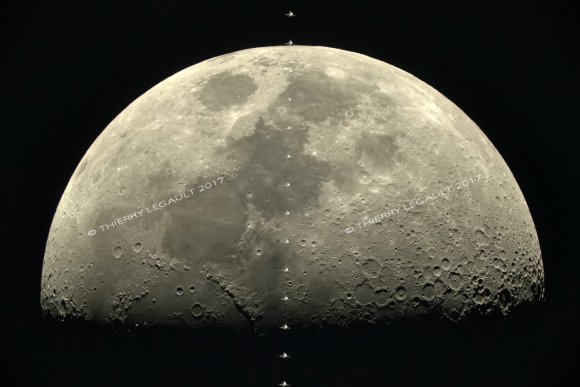
Expedition 50 with French astronaut Thomas Pesquet on February 4, 2017. Filmed with Celestron C14 EdgeHD and Sony Alpha 7S from Rouen, France (Pesquet’s birth city). Credit and copyright: Thierry Legault. Used by permission.
Thanks to Thierry for sharing his footage and images with Universe Today. Keep track of his amazing work at his website.
Explody Eta Aquarid Meteor Caught in the Act
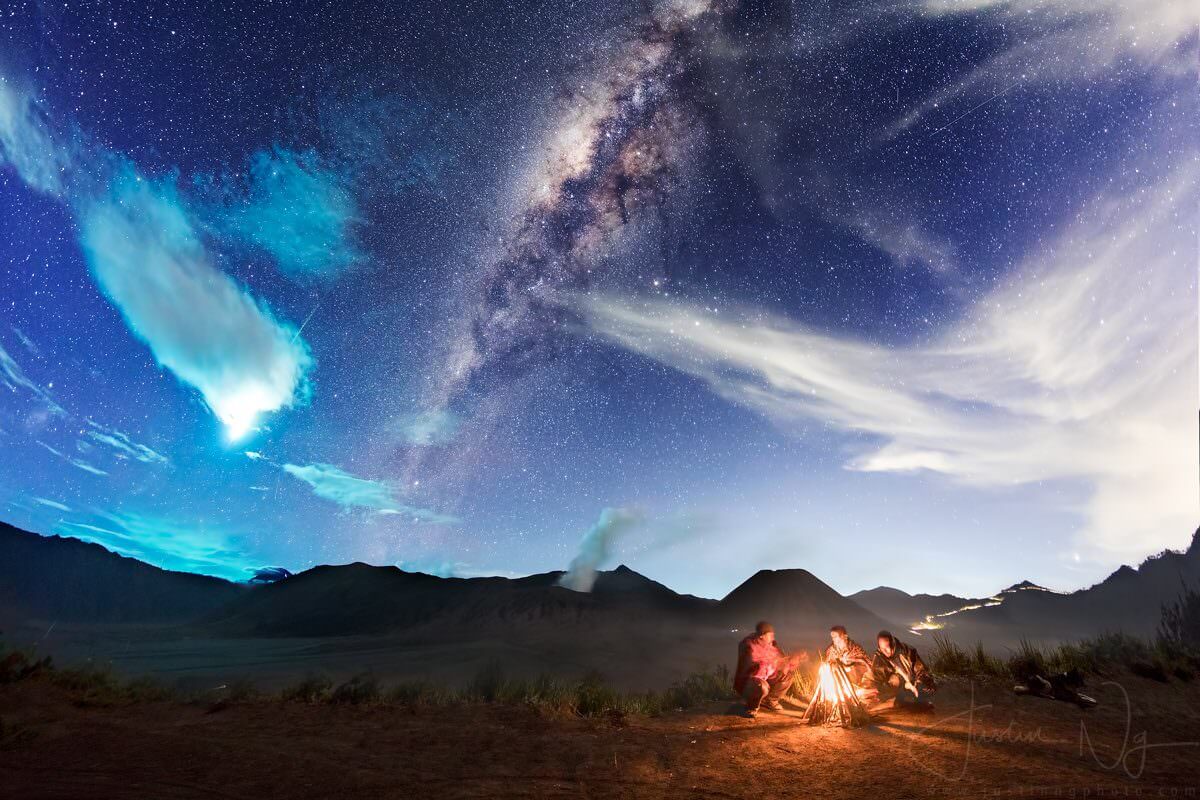
An Eta Aquarid meteor captured on video by astrophotographer Justin Ng shows an amazing explodingred meteor and what is known as a persistent train — what remains of a meteor fireball in the upper atmosphere as winds twist and swirl the expanding debris.
The meteor pierced through the clouds and the vaporized “remains” of the fireball persisted for over 10 minutes, Justin said. It lasts just a few seconds in the time-lapse.
Here’s the video:
Justin took this footage during an astrophotography tour to Mount Bromo in Indonesia, where he saw several Eta Aquarid meteors. The red, explody meteor occurred at around 4:16 am,local time. The Small Magellanic Cloud is also visible just above the horizon on the left.
Eta Aquarid meteor piercing through cloud and left behind a red smoke trail that lasted for over 10mins. Taken in Mt. Bromo 8hrs ago. pic.twitter.com/WtFl9TGRbj
— Justin Ng (@justinngphoto) May 6, 2017
Persistent trains occur when a meteoroid blasts through the air, ionizes gases in our atmosphere. Until recently, these have been difficult to study because they are rather elusive. But lately, with the widespread availability of ultra-fast lenses and highly sensitive cameras, capturing these trains is becoming more common, much to the delight of astrophotography fans!
Mount Bromo, 2,329 meters (7600 ft.) high is an active volcano in East Java, Indonesia.
Check out more of Justin’s work at his website, on Twitter, Facebook or G+.
6 May 2017 – Eta Aquarid Captured at Mount Bromo (4K Timelapse) from Justin Ng Photo on Vimeo.
Get Away From It All with these Amazing DTM Views of Mars
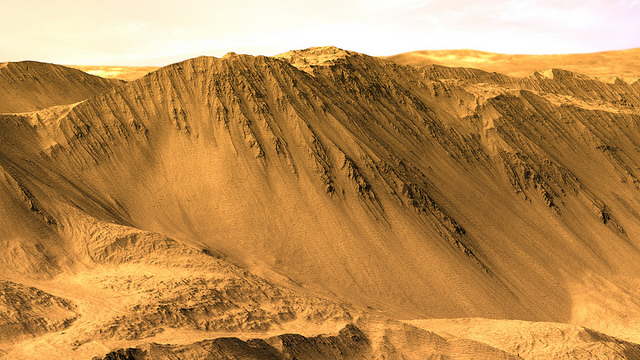
By day, Kevin Gill is a software engineer at the Jet Propulsion Laboratory. But on nights and weekends he takes data from spacecraft and turns them into scenes that can transport you directly to the surface of Mars.
Gill is one of many so-called “amateur” image editing enthusiasts that take real, high-resolution data from spacecraft and create views that can make you feel like you are standing on the surface of Mars, or out flying around the Solar System.
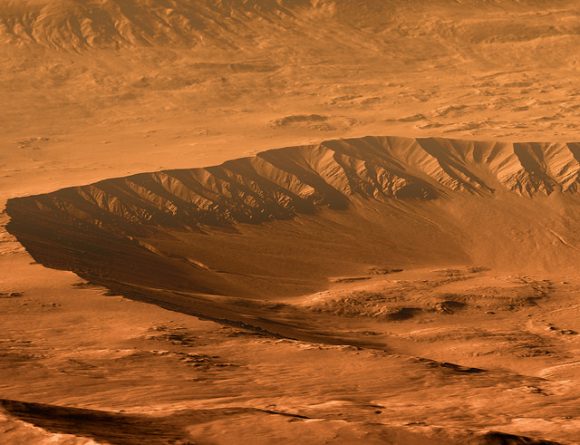
Some of the best data around for these purposes come from the HiRISE camera on board the Mars Reconnaissance Orbiter. Data known as Digital Terrain Model (DTM) files, the HiRISE DTMs are made from two or more images of the same area of a region on Mars, taken from different angles. This data isn’t just for making stunning images or amazing movies. For scientists, DTMs are very powerful research tools, used to take measurements such a elevation information and model geological processes.
So, just how do you go from this DTM image from HiRISE:
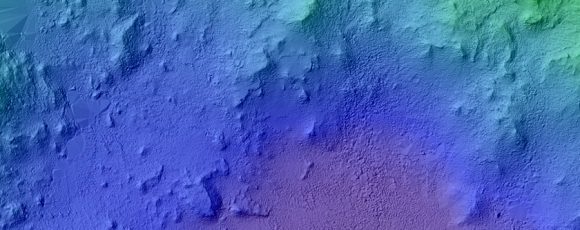
To this amazing image?
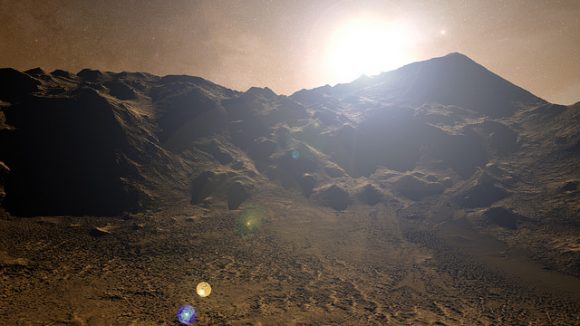
I’m going to let Kevin explain it:
To prep the data, I use Photoshop (to convert the JP2 file to a TIFF), and then standard GIS tools like gdal (Geospatial Data Abstraction Library) to create textures for 3D modeling. Using Autodesk Maya, I input those into a material as a color texture (orthoimagery) or displacement map (the DTM data).
I connect that material to a NURBS plane (sort of like a polygon mesh) that is scaled similarly to the physical properties of the data. I set up a camera at a nice angle (it takes a number of low-resolution test renders to get an angle I like) and let it render.
Then I just pull that render into Photoshop where I have a series of monochromatic color tints which gives the image it’s Martian feel. For the sky, I use either a sky from a MSL MastCam image or one that I took outside with my cell phone. If I’m using a sky I took with my cell phone, I’ll adjust the colors to make it look more like it would on Mars. If the colors in the image are still boring at this point, I may run a HDR adjustment on it in Photoshop.
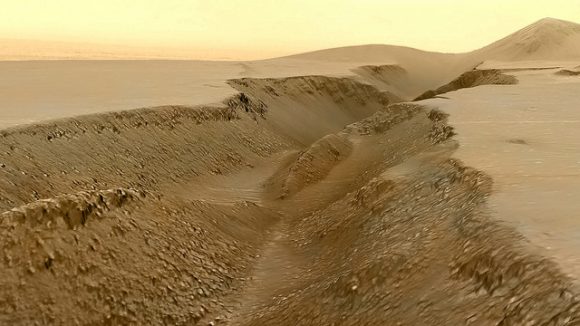
What all this means is that you can create all these amazing view, plus incredible flyover videos, like this one Kevin put together of Endeavour Crater:
Or you can have some fun and visualize where the Curiosity rover is sitting:
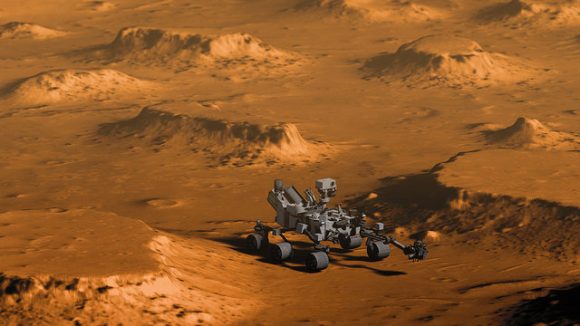
We’ve written about this type of image editing previously, with the work of the people at UnmannedSpaceflight.com and others. Of course, the image editing software keeps improving, along with all the techniques.
Kevin also wanted to point out the work of other image editing enthusiast, Sean Doran.
“Sean’s work is resulting in views similar to mine,” Kevin said via email. “I know he’s using a process very different from mine, but we are thinking along the same lines in what we want out of the end product. His are quite impressive.”
For example, here is a flyover video of the Opportunity rover sitting along the rim of Endeavour Crater:
@MarsRovers Oppy Flyby2, tighter with atmosphere HD: https://t.co/fLjVrlLu73 pic.twitter.com/9DCQX8aGXG
— Seán Doran (@_TheSeaning) February 1, 2017
You can see more of Sean’s work on his Flickr page
And you can see all of Kevin’s Mars DTM images at his Flick page here. Kevin also recently wrote up a great explanation of his image editing for The Planetary Society, which you can read here.
Thanks to Kevin Gill for sharing his images and expertise!

